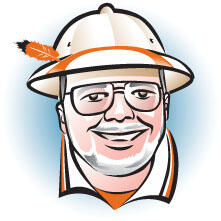"We all know that art is not the truth, art is a lie that makes us realize the truth."
— Pablo Picasso
It is doubtless a comfort to us all to know that the Campus Art Steering Committee (which I presume is focused more on creativity than on shuttle buses?) is on the case as Princeton marches relentlessly southward. Having aestheticized such popular new digs as 1967 Hall, Sherrerd Hall, and the P-rade arch of Bloomberg Hall, they have turned to the sizable challenge of the University’s second-largest academic building, the new Frick Hall on the old Armory site next to Princeton Stadium. Given a humongous interior space to work with, they’ve chosen some lighter-than-air imagery in the form of Kendall Butler’s “Resonance,” which at least to me acts as a fortuitous melding of the interior light and the exterior sky that assists significantly in making the huge building seem as natural as possible. Hopefully the nice folks in the many labs, while cooking up superduperglue or new flavors for cough drops or whatever they’re up to, will find a little uplift from the installation and the fine green exterior views from the glass-walled box.
This new spate of three-dimensional artistry recalls the appearance 40 years ago of the first huge wave of Princeton exterior sculpture (if you don’t count the gargoyles), the Putnam Collection. Announced in a low-key way in the spring of 1969 with no indication of magnitude, the fund anonymously honors highly decorated World War II ace John B. Putnam Jr. ’45, who died flying in England after taking part in D-Day in 1944. Although a small blue-ribbon panel was chosen to commission the sculptures (e.g. Thomas Hoving ’53 of the Met in New York, Alfred Barr ’22 *23 of MoMA), the project advanced almost surreptitiously; the first sculptures that were site-tested, unannounced, were described in October 1969 by the baffled Daily Princetonian as having “appeared, then vanished.” The University staffer who told the paper of the connection to the Putnam grant refused to be quoted. About a month later, the true scope began to emerge: The gift was $1 million, the names of Picasso, David Smith, and Jacques Lipschitz surfaced. On Dec. 1, Tony Smith’s “Moses” appeared on Prospect lawn, followed the next day by Lipschitz’s “Song of the Vowels” on Firestone Plaza, and the collection was open for business. Eventually encompassing 20 sculptures installed over the next two years, this apparently means the average fee for large original pieces by such as Louise Nevelson, Alexander Calder, and Henry Moore was $50,000, almost incomprehensible today, when that will barely get you a tricked-out SUV. Of course, keep in mind that Jadwin Gym was being built simultaneously for $6.9 million.
The resulting monumental collection, spread liberally around the campus, is inevitably uneven in style, reflecting mainly experimental artists at the peak of their maturity, but quite liberating in its abstraction and the assertiveness of strong personalities. For some reason, possibly just coincidence, I’ve always been most drawn by some of the biggest names: the Lipschitz, Moore’s “Oval with Points” next to the registrar’s office (probably the crowd favorite, and a crucial hole on the campus Frisbee golf course), Calder’s huge “Five Disks: One Empty” on Fine Hall Plaza.
And then there’s Picasso – which is a good summing up of 20th-century art in one sentence, if you think about it. It was thought-provoking to see him portrayed recently in Woody Allen’s Midnight in Paris, chatting away at Gertrude Stein’s place with Scott Fitzgerald ’17; they were roughly contemporaries – Fitzgerald was 15 years younger – but Picasso was still the dominant artistic figure on the planet when the Putnam committee commissioned his “Head of a Woman” in 1969. Although he was 90 years old at the time, Picasso’s sculpture was hugely current: He had just in 1967 completed the still-famed 50-foot Chicago Picasso on Daley Plaza, and he had a working partner, Norwegian artist Carl Nesjar, who had built a concrete commission for Picasso at NYU. Choosing to repeat that process, the Putnam commissioners agreed to a stone version of a seven-year-old metal Picasso working model for the collection’s symbolic centerpiece smack in front of the Art Museum; it was built by Nesjar on the site using crushed stone from Norway and poured concrete. The resulting two pieces (the column was done first) were sandblasted to reveal the colored stone, and the 1971 result was as definitively Picasso as you ever could imagine.
Now, far be it from me to attribute ulterior motives to the cultural arbiters of our fair University, but it seems fair to note that in 1969 Princeton formally took the plunge into coeducation, and the simultaneous showcasing of a monument entitled “Head of A Woman” sent a consistent message at the very least. Of course, Picasso was a logical way to go if you were going to feature ladies; his dozens of works referred to as “Head of a Woman” alone stretch back to at least 1909 in every imaginable static medium, of which the huge Princeton Art Museum installation was simply the logical extension. (Probably safer than some alternatives, too; many of his female-oriented paintings and drawings of the late period were probably not the perfect, uh, message for parents of high school junior women on campus tours.)
Anyway, the sculpture very quickly became a comfy landmark, visible from Cannon Green and uniquely identifiable. So much so that apparently one of its more blatant attributes was neglected when it came time to expand the Art Museum and upgrade McCormick Hall at the turn of the century. Namely, that much concrete weighs a lot. While it was obvious that the work had to be moved to allow the underground construction of the facility toward McCosh Walk, it was apparently more surprising that the resulting new structure was completely incapable of supporting it even when complete. The resulting image of “Head of a Woman” walking the streets, as it were, seemed none too desirable, so the 2002 campus guardians of the arts went about finding the right relocation for the work, knowing full well it couldn’t possibly be as visible as the original site. If they weren’t a Steering Committee beforehand, they were afterward.
[node:field-image-collection:2:render]
Their solution, the front lawn of Spelman Halls, was fortuitous on multiple levels. Being near the Dinky, it gets seen (and will be seen even more when pedestrian circulation changes following the relocation of the station slightly southward). Being opposite New South, it hopefully means many people will look away from the building, which richly deserves it (N.B. there may be some help in store from the opening up of the New South ground-floor exterior during the relocation of arts operations to the lower campus; it certainly can’t hurt). And the backdrop of Spelman, a concrete echo of the sculpture with plenty of green interspersed to soften the edges, is highly complementary on multiple levels, not only in surfaces but symbolically: The dorms are the pivotal gift of trustee and alumni leader Laurance Rockefeller ’32, part of his landmark gift that enabled coeducation to take place with first-rate facilities, and named for his mother and namesake, Laura Spelman Rockefeller. The confluence of the two significant 1969 gifts 33 years later and down the hill is the type of aesthetic touch that is rare in the best of times and circumstances, and needs to be appreciated when it occurs.
And for the philosophy majors, the ability of Picasso’s cubist image to handle all the symbolic weight of pointing up the titan of 20th-century art, the import of coeducation, the expansion and enrichment of the campus southward, and the munificence of the Putnam donor(s?) and Rockefeller seems obvious in its solidity, its acuity (it looks at you from any angle), and, not least at all, its eerie resemblance to a tiger from the side – take another look at the truckin’ picture above.
A woman tiger, of course: Dei sub numine viget.














No responses yet